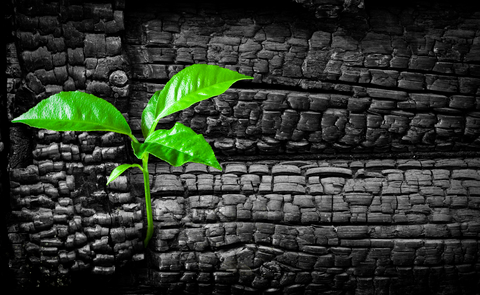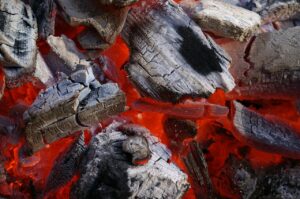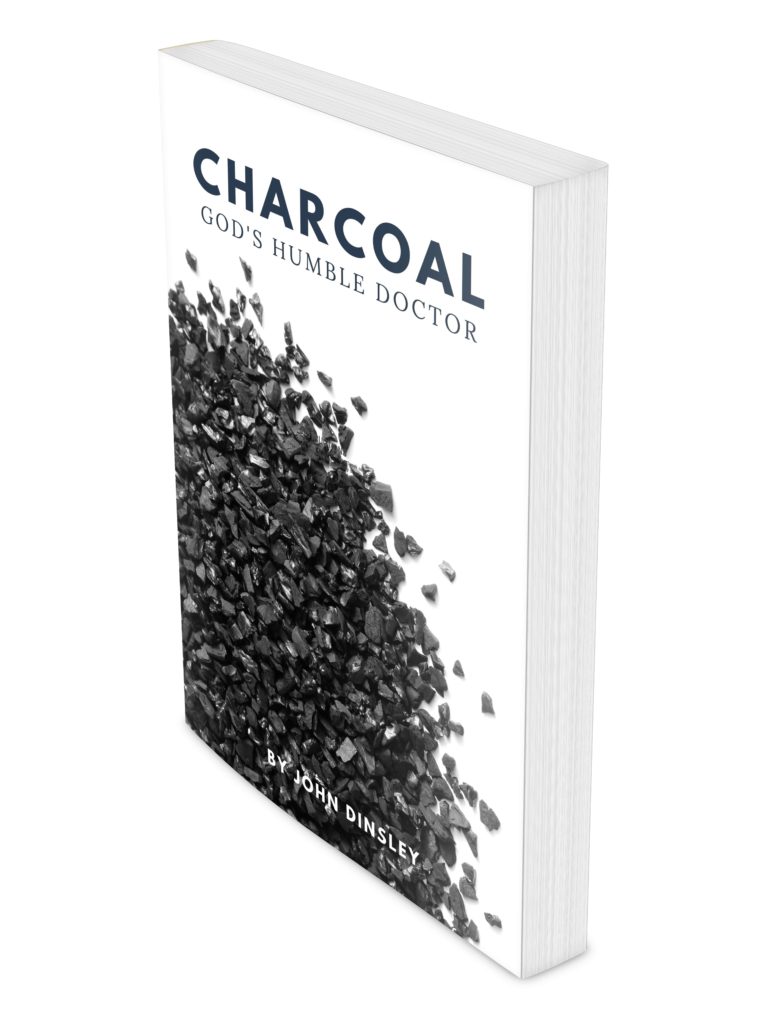
This is just a brief look at activated charcoal and simple biochar (garden charcoal) and some of the ways it is employed in benefiting gardeners and the soil they grow their food in.
In February of this year I was in Uganda teaching about the medicinal uses of charcoal for people and animals. But we also briefly discussed the benefits of biochar (aka charcoal from renewable sources like trees, nuts, chicken manure…) in soil management. I invited Julius Turyamwijuka who was featured on www.biochar-international.org for his work with biochar and stoves. He kindly accepted and came to Kalagala village to explain the benefits of using biochar to enrich the soil, increase plant growth, and crop production. Again, the people were amazed to discover a “natural” fertilizer that was readily available and affordable.
I continue to explain to people, charcoal is medicinal for our bodies, our animals, but also for the land we grow our food on. Recently I received an email from a friend working in northern Uganda. He is a believer and promoter of charcoal as a medicinal. He briefly mentions this very real benefit from incorporating biochar/charcoal around banana trees:
 “On another positive note, a friend of mine has testified that, when I told him charcoal powder can renew soil productivity and rids soil of crop diseases, he tried the idea by pouring charcoal powder under his banana plantation which had been attacked by some terrible banana wilt diseases which is a bad menace to farmers here in Uganda. He testified that, after about 3 months since he acted, the wilt has disappeared and he is planning to expand the idea to other fields. I thought you should note this one. When I get time, I will go with him to the field to take photos of these events.
“On another positive note, a friend of mine has testified that, when I told him charcoal powder can renew soil productivity and rids soil of crop diseases, he tried the idea by pouring charcoal powder under his banana plantation which had been attacked by some terrible banana wilt diseases which is a bad menace to farmers here in Uganda. He testified that, after about 3 months since he acted, the wilt has disappeared and he is planning to expand the idea to other fields. I thought you should note this one. When I get time, I will go with him to the field to take photos of these events.
God bless you.”
Ronald
We invite others who have had similar results with charcoal/biochar with various plants/crops to please contact us. Remember, pictures are worth a thousand words.
Speaking of pictures check out these Record Giant Pumpkin grown with Charcoal Green® Biochar Plus.
RESOURCES
1. There are numerous websites that can get you tuned to this amazing new discovery in agriculture (used extensively over 800 years ago in the Amazon jungles of Brazil). Check out the links on the Gardens & Farms page to get you started.
2. For a truly up to date book/reference on what biochar is and can do for you and for the world environment get The Biochar Revolution – Transforming Agriculture & Environment by Paul Taylor PhD. A friendly, informative, inspiring, and break-through reference guide for anyone interested in biochar (aka garden charcoal) or concerned about environmental issues. The book has contributions from 18 of the whose who in the worldwide biochar movement.
Rye Grass Seed Production
One indispensable part of the planting schedule for the rye grass seed industry is activated charcoal (AC). The application of AC over the seed row to ‘safen’ a crop to pre emergent herbicides has been a common practice in grass seed production in Oregon for over forty years. For decades rye grass seed growers have been incorporating AC during the fall planting as a slurry. Because of the extensive use of pre emergent sprays and other herbicides, AC is vital in controlling the toxic build up of these chemicals in the soil.
AC powder is mixed with a venturi into a water slurry (with a liquid fertilizer) and applied over the seed row. It is critical to keep the suspension agitated because if the charcoal is allowed to settle out it is very difficult to re-agitate into a suspension
Up until recently coal-based AC has been the standby treatment for the rye grass seed farmer, but field trials by Oregon State University have shown wood-based AC to be much superior—25lbs/acre (plus N & P 40 gal. acre) instead of more than twice as much coal-based AC.
As an added benefit the wood-based AC stays in suspension much longer and can be easily agitated back into suspension after being allowed to settle out for 2 months—a great cost/time/labor saving feature.
Pineapple Plantation
One customer contacted us several years ago for a remedy for their pineapple plantation that was suffering under the longterm use of Hyvar X®(Bromacil). Hyvar X® is a potent herbicide used for general weed or brush control in non-crop areas. It is used to control perennial grasses and is specifically recommended for selective weed control in citrus groves and on pineapple plantations.
They purchased 238,000lbs of Charcoal Green® Soil DeTOX and within 2 weeks were able to begin replanting.
Cow Manure Biochar
Abstract
Biochar (BC) produced from agricultural crop residues has proven effective in sorbing organic contaminants. This study evaluated the ability of dairy-manure derived biochar to sorb heavy metal Pb and organic contaminant atrazine. Two biochar samples were prepared by heating dairy manure at low temperature of 200° C (BC200) and 350° C (BC350). The untreated manure (BC25) and a commercial activated C (AC) were included as controls. Sorption of Pb by biochar followed a dual Langmuir-Langmuir model, attributing to Pb precipitation (84-87%) and surface sorption (13-16%). Chemical speciation, X-ray diffraction, and infrared spectroscopy indicated that Pb was precipitated as beta-Pb9(PO4)6 in BC25 and BC200 treatment, and as Pb3(CO3)2(OH)2 in BC350. Lead sorption by AC obeyed a single Langmuir model, attributing mainly to surface sorption probably via coordination of Pb d-electron to C==C (pi-electron) and -0-Pb bonds. The biochar was 6 times more effective in Pb sorption than AC, with BC200 being the most effective (up to 680 mmol Pb kg(-1)). The biochar also effectively sorbed atrazine where atrazine was partitioned into its organic phase, whereas atrazine uptake by AC occurred via surface sorption. When Pb and atrazine coexisted, little competition occurred between the two for sorption on biochar, while strong competition was observed on AC. Results from this study indicated that dairy manure can be converted into value-added biochar as effective sorbent for metal and/or organic contaminants.
Environmental Science Technology (2009) American Chemical Society, Volume: 43, Issue: 9, Pages: 3285-3291
PubMed: 19534148
Available from www.ncbi.nlm.nih.gov
Deoyani Sarkhot is a postdoctoral fellow at the University of California, working with professors Dr. Asmeret Berhe and Dr. Teamrat Ghezzehei. They purchased Pure Black Biochar to use for some of their experiments related to the dairy industry.
Cow Manure Biochar
Abstract
Amending soils with biochar can have multiple environmental benefits, including improvement in soil physicochemical properties, carbon sequestration, reduction in leaching losses of essential nutrients, and reduction in greenhouse gas (GHG) emissions. This study was conducted to determine the effect of enriched biochar amendments on leaching losses of essential nutrients and GHG emissions from soil. The enriched biochar was prepared by shaking biochar with dairy manure effluent for 24 h, which increased the C and N concentration of biochar by 9.3 and 8.3%, respectively. Incubation and leaching experiments were conducted for 8 wk with three treatments: soil, soil + 1% biochar, and soil + 1% enriched biochar. Amendment with biochar and enriched biochar relative to unamended soil resulted in 68 and 75% reduction in net nitrification, 221 and 229% reduction in net ammonification, 67 and 68% reduction in cumulative CO2 flux, respectively, and 26% reduction in cumulative N2O flux for both biochar treatments. There were no significant differences among treatments in total leaching losses of C, N, and base cations. Our findings suggest that enrichment of biochar with dairy manure effluent can promote C and N storage in soil and provide additional environmental benefits. Journal of Environmental Quality (2011)
Issue: 1959
DOI: 10.2134/jeq2011.0123
For questions related to these experiments Deoyani Sarkhot can be reached at deoyani2000@yahoo.com
Biochar in Vineyards
Claudio Niggli und Hans-Peter Schmidt
With soil depletion in vineyards often reaching extreme dimensions, the use of biochar seems a very promising way forward. Two years ago the Delinat Institute started the first large-scale biochar experiment in Europe. The results come not only as a surprise for skeptics, but also far exceed the expectations of optimists. Click for PDF file
Submitted by:
The Agriculture, Forestry and Fisheries Research Information Technology Center (Japan)
Summary:
Effects of several kinds of charcoal applied to soil on citrus growth and vesicular-arbuscular mycorrhizal (VAM) development were investigated. Satsuma mandarin (Citrus unshiu Marc.) trees on trifoliate orange (Poncirus trifoliata Raf.) rootstocks were transplanted to root boxes using the soil mixed with charcoal derived from rice husk, citrus juice sediment or western spruce bark. The trees were inoculated with the spores of Glomus fasciculatum (Thaxter) Gerdemann and Trappe emend. Walker and Koske. Elongation of the roots in the charcoal treatments was more vigorous than that in the charcoal-free control. The fresh weights of the root, shoot and the whole tree increased in response to charcoal application. The intensity of VAM infection in any charcoal treatment was higher than that in the control. In particular, the percentage of the infection in the rice husk charcoal plot was 41.5 and P concentration in the leaf exceeded that of the control. In a Citrus iyo orchard, the percentage of VAM infection was 52% in the rice husk charcoal plot, the highest among plots. The intensity in the Bahia grass (Paspalum notatum Fluegge.) plot was next, followed by the third highest rate found in the abandoned plot which had not been cultivated in recent years. The lowest percentage of VAM infection was in a clean-culture plot.
Journal of the Japanese Society for Horticultural Science; Vol. No.v. 63(3) p. 529-535, Dec 1994
A study was conducted to determine the efficiency of using Moso bamboo [Phyllostachys pubescens] charcoal on the improvement of soil and water quality….
Soil improvement was carried out by mixing coarse, fine, or powder of bamboo charcoal grains at 10, 20, and 30% with sediment red soil by volume. The average height of Chinese cabbage grown at bamboo charcoal mixed soils was 24% higher than that grown in original soils, and charcoal powder mixed soil treatment showed the best result, i.e., 33%. The average number of leaves per Chinese cabbage grown in bamboo charcoal mixed soils was 64% more than that grown in original soils. The fresh weight of plants grown in powder, fine, and coarse charcoal grain mixed soils were 149, 33, and 74% heavier than these cabbages grown in original soils, respectively, which showed the effectiveness in soil improvement by bamboo charcoal.
Yeh MinChyuan; Hu YingShiang; Huang MengShyun; Su SheauJing; Dong PeiLing, Forest Products Industries 22(4): 285-294, 2003
For more information on Biochar products for gardens and farms, and more tutorials go to CharcoalGardens.com


Also, be sure to get the book The Biochar Revolution by the whose who of the Biochar movement.
Baker Creek Spring Seed Festival
This past April, Kimberly and I traveled to Missouri to show our stuff at the more and more popular Baker Creek Spring Planting Festival. Baker Creek is the largest distributor of heritage seed. We felt right at home with the 7,000 other guests who came to discover what is new from the old world of agriculture. We met many people and were able to acquaint many with the wonders of charcoal for people, pets and livestock, AND for agriculture. It was a very interesting and packed experience. We left exhausted but re-inspired in “We the people…”



